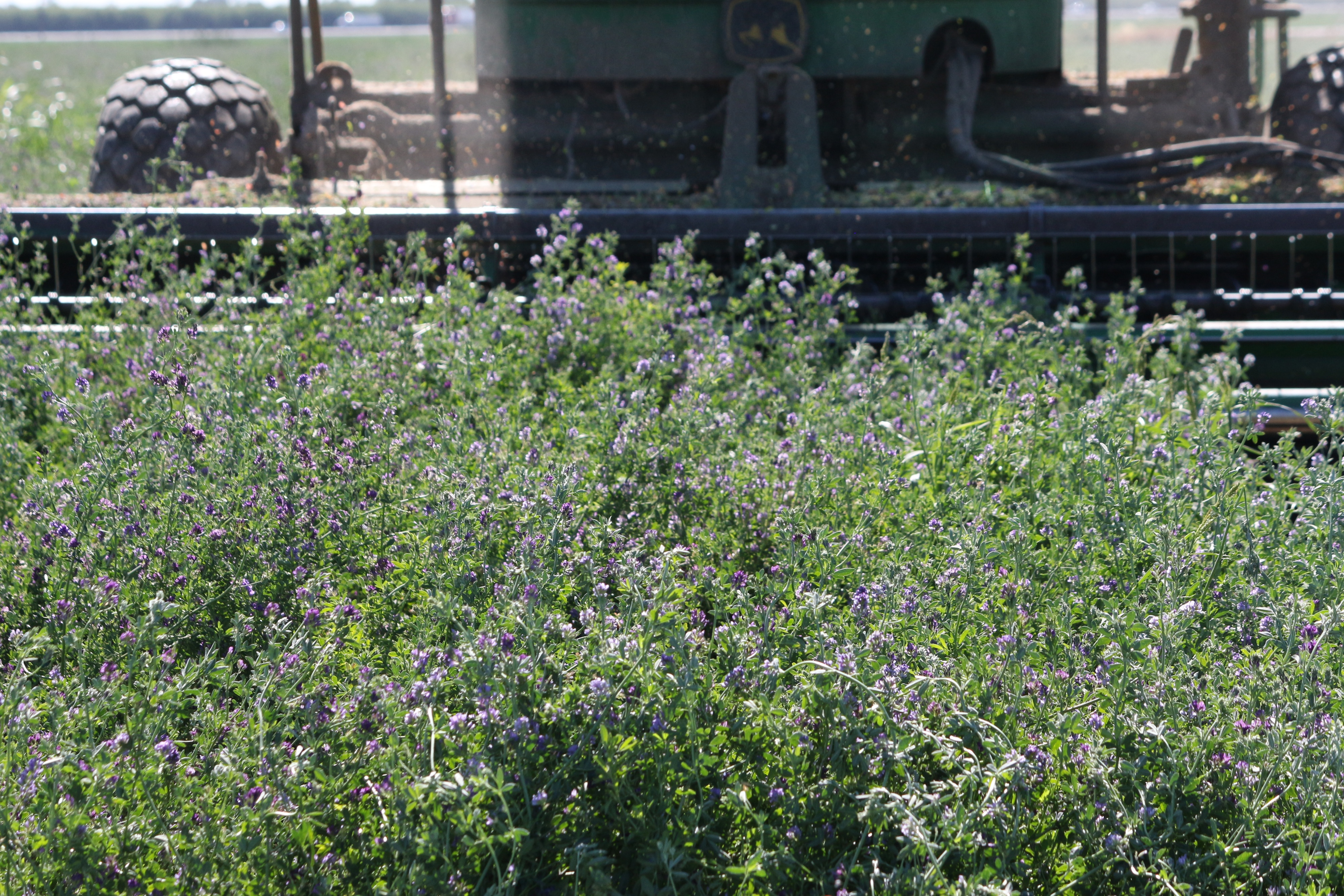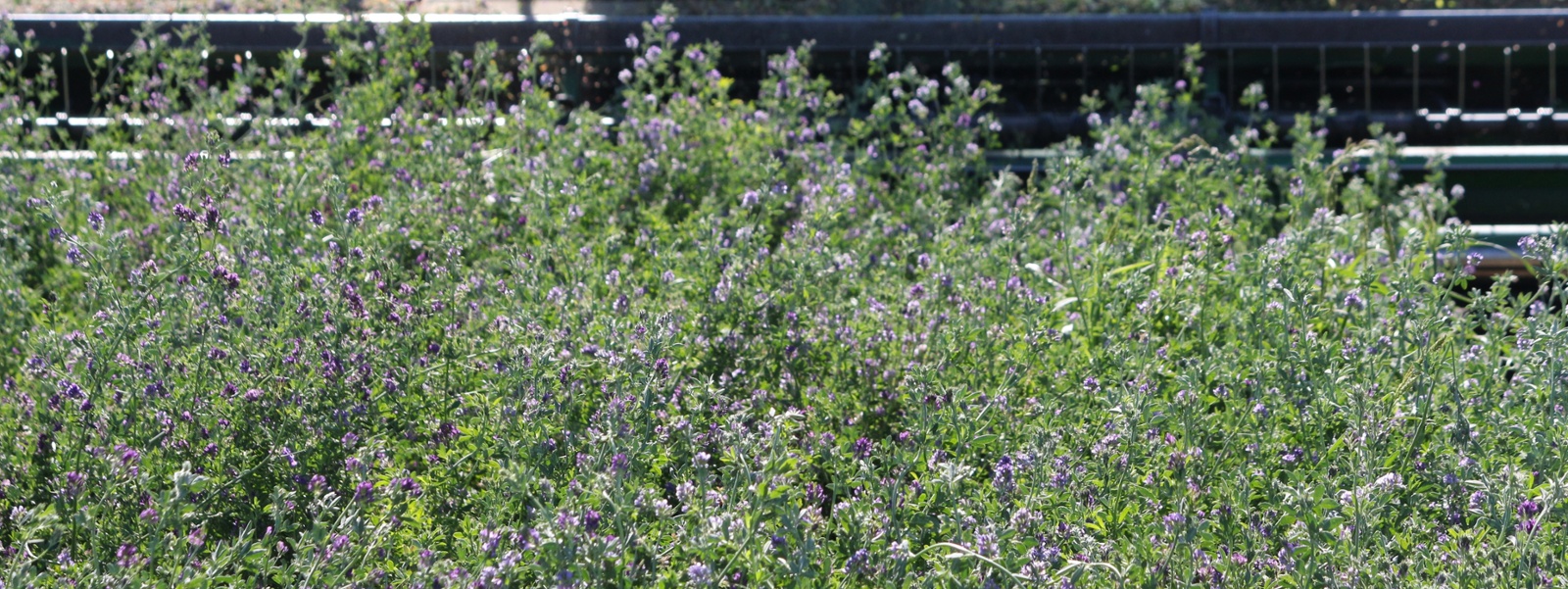Tariff impacts weigh on hay exports, dim market outlook

Alfalfa is harvested in Yolo County in 2023, in its second cutting of the season.
Photo/Ching Lee

By Ching Lee
Hay producers have already faced falling prices for the forage in recent years, and impacts of President Trump’s tariff policies add new pressures and market disruptions that could further dampen the sector’s outlook.
Hay supplies have rebounded from levels during the drought, contributing to lower prices. Though strong domestic demand has kept California hay prices steady so far this year, export activity has been limited, according to a report last month by AgWest Farm Credit.
“If tariffs continue to disrupt trade, Western exporters could face significant challenges,” the agricultural lender said.
Most hay exports are compacted and bound into smaller bales for shipment. To meet rising demand from China—which accounted for 30% of total U.S. forage exports last year—hay exporters have increased production of compressed hay during the past decade. But tariffs now threaten this trade, Farm Credit said.
Before the U.S. and China called a 90-day truce last month, Trump imposed 145% tariffs on Chinese imports, and China responded with 125% tariffs on American goods. That effectively halted all hay shipments to China, said Gerard Irungaray, an owner of Imperial County-based Triple I Press, which exports hay.
“Their end user can only pay so much,” he said.
When tariffs are imposed, exporters oftentimes would be forced to lower their price to make it more palatable for buyers, but at 125%, “we can’t drop our price that much,” Irungaray said.
With the 90-day pause, the U.S. has lowered its tariffs on Chinese imports to 30%, and China has decreased its import duty on American products to 10%.
While the reduced rate has helped, Irungaray said, the strong value of the dollar—which makes American goods more expensive for foreign buyers—reduces demand and market share abroad.
“Exports have been fairly slow for the last few years, and it’s mainly because of our exchange rates,” he said. “For our industry, we need to have a weaker dollar. It’s a matter of them (foreign buyers) being able to afford it.”
Farm Credit noted that international buyers stockpiled hay ahead of the tariffs, which boosted Western prices and tightened supply. They changed course after the tariffs were announced by canceling orders, with China reducing its alfalfa hay purchases. Buyers overseas now seek alternative suppliers, the lender reported. Irungaray said hay-growing regions in Europe, South America, Australia and Canada would be competing for this business.
“With our strong dollar and their weaker currency, they basically have a price advantage,” he said.
During Trump’s first term, when the U.S. and China were engaged in a similar tit-for-tat tariff conflict, the Asian nation retaliated with a 25% tariff on top of an existing 8% tariff on American hay. This led to decreased sales for U.S. hay exporters as Chinese buyers turned to other regions for the forage.
“That’s why the (U.S.) hay export business has been in the tank,” said Imperial County hay grower Ronnie Leimgruber.
In 2018-19, increased imports from the Middle East helped eased some of the pressure. But that market today cannot fully replace lost Chinese sales, Farm Credit warned.
China remains a “huge buyer” of California hay, Leimgruber said, but with its economy slowing, it is not as big a market as it was several years ago. Other Asian countries such as Japan, South Korea and Taiwan also are major buyers. The Middle East, especially Saudi Arabia, has become a top destination for California hay “because oil prices are good, and they’ve got money to buy our product,” Leimgruber said.
The loss of export business is not the only factor dragging down domestic hay prices. The nation’s low cattle numbers is another reason, said Dale Tyson, an Imperial County hay grower and exporter.
Prolonged drought, poor pasture conditions, and high costs for feed and other inputs led ranchers to reduce their herds. With fewer mouths to feed, demand for hay and other feed has fallen.
“You can’t just rebuild the cattle herd overnight,” he said. “It takes several years, and it’s a slow increase.”
California hay growers are expected to harvest 870,000 acres of the forage this year, according to the U.S. Department of Agriculture March prospective plantings report. That’s down from 940,000 acres in 2024.
Meanwhile, Trump’s new tariffs, particularly on imports from China, have slowed cargo volume at major U.S. ports.
The Port of Los Angeles, for example, saw imports in May drop 9% from a year ago and 19% compared to April due to tariff impacts, the port said last week. Average ocean container bookings to the U.S. fell 17% in April, with those specifically from China down 34%, Farm Credit reported.
Lower import volumes affect the availability of shipping containers and vessels for agricultural exporters, which may see rates rise due to reduced supply.
Irungaray of Triple I Press said the cost to ship has so far remained relatively unchanged, but finding available space is getting tougher.
Whereas he used to be able to ship every week, there are now weeks when he can’t ship any hay.
“It makes it inefficient. It delays our shipment,” he said.
Grower Leimgruber said he remains optimistic about what Trump is trying to do and that he thinks “it’s going to be better for agriculture” in the long run.
“But in the short term, it’s going to be tough,” he said. “There’s going to be winners and losers. And if you’re in the export business, you’re going to be a loser.”
Ching Lee is editor of Ag Alert. She can be reached at clee@cfbf.com.




